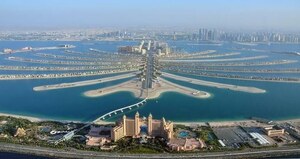Following $600mn Ambani wedding, India has set the stage for its next growth phase, Pakistan is still lost
At last, the global spectacle has come to an end. The last scion of the Ambani family has completed his grand trifecta celebrations spanning 5 months and the planet can return to its regular orbit.
Oh, and around the same time, Spain won the Euro Cup, Spaniard Carlos Alcaraz stole the Wimbledon crown from Novak Djokovic again, and Pakistan contemplated banning former Prime Minister Imran Khan’s political party.
But back to the (very deliberate) spectacle of the century.
Canary, pink and orange diamonds were in tow at Anant Ambani’s celebrations, while Italy’s famed Il Borro and Singapore’s Hutong were transported to Mumbai.
For perspective, just one of Nita Ambani’s necklaces was worth $60 million while another piece, a 52.58-carat diamond ring titled ‘Mirror of Paradise’, can be traced back to the Mughal era in the 1800s.
It was reportedly auctioned by Christie’s in 2019, originating from the famed Golconda mines – home of the Koh-i-Noor.
It is India’s time on the global stage; Pakistan is nowhere near it
And the global media ate it right up.
“Bollywood Stars, Prime Ministers and the Kardashians Attend the Ambani Wedding,” wrote The New York Times, referring to the family’s strategic partnerships with Boris Johnson, Tony Blair, John Kerry and PM Narendra Modi.
The pre-wedding celebrations in Jamnagar drew Bill Gates, Mark Zuckerberg and Bob Iger.
That, paired with the appearances of Rihanna, Katy Perry, Justin Bieber and Andrea Bocelli, the collective global influence was well on display.
The world sat up and took note(s).
The Guardian estimated the cost of the affair at around $600 million.
No doubt an excellent branding technique, the digital footprint that the spectacle created will likely spur a launching pad for the next set of Reliance-backed ventures and a move towards a more cohesive and aggressive global footprint as the next generation of scions are primed to take over Mukesh Ambani’s sprawling $123 billion empire.
India’s Reliance, Bollywood fuel Ambani wedding hype through social media
India’s economic reforms
The Ambani empire – comprising of petrochemicals, oil and gas, telecom, retail and financial services – was in large part a formulaic and strategic rise championed in no small part through reforms by former prime minister Manmohan Singh.
In 1991, Singh, as Finance Minister, abolished the Licence Raj, a source of slow economic growth and adopted a free market policy which led India’s burgeoning middle class see rapid growth, opening up the economy to competition, trade, innovation and enterprise.
This move liberalised the Indian economy and positioned it to become a global player.
During 2004-2012, India’s middle class doubled from 300 million to 600 million, placing considerable wealth and purchasing power into the hands of these newly-minted dollar millionaires.
Then, current Prime Minister Narendra Modi’s ‘India First’ campaign followed, with subsidies and tax breaks for businessmen like Gautam Adani and Mukesh who were tapped to shape India’s global image and drive exponential growth.
Additionally, India’s rules on foreign direct investment protected the national team of moguls from global rivals.
A technological hub was already in progress, which no doubt helped India ride the digital wave of the 2000s seamlessly.
Earlier, in the 1970s, the Indian government had begun investing in Bangalore’s tech sector, attracting foreign giants such as IBM to set up shop.
Now, Asia’s “silicon valley” houses Apple, Google, Facebook among others and its 10,000+ startups raised over $10.8 billion in funding in 2022.
Bill Gates, while attending the celebrations in Jamnagar, even called India home to “incredible innovators”, in a (now viral) video of him at a local tea shop.
Perhaps, it’s pertinent to note that in the early years following partition, India was quick to invest in engineering and technological schools, no doubt providing the basis for this meteoric rise.
The era of wealth creation
The cultural fabric of India also changed along with the socio-economic milieu as the country embraced the propensity of the wealthy to spend, not unlike China where a penchant for and access to luxury goods and services came to define this era of prosperity.
Euromonitor has estimated the personal luxury market in India to expand almost 12% a year in 2022-2026 to nearly $5 billion in contrast to the slowing demand in China.
All eyes are on India, that’s for sure. The ‘Billionaire Raj’ – led by India’s modern bourgeoisie – is now “more unequal than the British Raj headed by the colonialist forces,” according to a recent study by the World Inequality Lab.
India’s 1.4 billion population, the world’s biggest, has a per capita income of just $2,300, but the country is also home to more than 800,000 dollar millionaires who are eager to splurge on luxury homes and expensive SUVs.
Real estate consultant Knight Frank estimated India will have 1.4 million millionaires by 2026, 77% more than in 2021, as the economy continues to strengthen.
Knight Frank’s 2024 Wealth Report has also projected India’s wealth to grow by 50% by 2028, while the number of Ultra High Net Worth Individuals (UHNWI) – $30 million or more – is expected to reach 19,908 in 2028, from 13,263 in 2023.
Asia’s wealthiest man takes global rich to the zoo
Present day
India is currently the world’s world’s fifth-largest economy set to expand between 6.5% and 7% this fiscal year, with consumer spending expected to reach $5.2 trillion by 2031.
The Ambanis have long remained instrumental in propelling India to the global stage, demonstrated also by the glitzy opening of the Nita Mukesh Ambani Cultural Centre (NMACC).
Isha Ambani – director at Reliance Retail – has been key in bridging the gap between Indian wealth and access to global luxury conglomerates.
This year, Gucci, Cartier and Louis Vuitton were among luxury brands to open stores at Jio World Plaza, as luxury firms and Reliance made a push to profit from strong economic growth and a rapid rise in the number of millionaires.
Jio World Plaza is located inside Reliance’s $1 billion business and cultural hub in Mumbai’s business district.
LVMH, Gucci to expand in India with new outlets in Reliance’s luxury mall
Over the course of the wedding, a staggering number of custom ensembles worn by the Ambani family was crafted by Indian couturier Manish Malhotra – a brand that Reliance owns 40% stake in.
Malhotra, too, is poised for his own global push with his first global flagship in Dubai Mall.
Isha is also set to launch The Wedding Collective in August — a wedding expo bringing together over 100 curated couture and jewellery vendors, such as Manish Malhotra, Abu Jani and Sandeep Khosla.
Following the $8.5 billion merger of Reliance’s media arm with Walt Disney’s television franchise in India – with 750 million viewers across the country – a public offering for the digital platform is set to be in the works worth an estimated $112 billion, according to reports.
This, followed by one for Reliance Retail, will further entrench Ambani’s position in the market.
A new consumer finance and payments unit is also in the works, as are investments in green energy, all set to mark and market the next decade of growth for Reliance.
Despite the criticism the Ambanis’ spending received, it has already been parlayed into multiple investments that will no doubt have bigger payoffs in the long term.
What is Pakistan upto?
While its neighbours make their wealth, influence and business acumen known across the globe, Pakistan is grappling with multiple crises.
Its salaried group is taking to the streets, industrial units are either announcing shutdowns or halting production, while organised sectors are protesting against taxation.
In most cities, people are also protesting against record high energy tariffs, and some are demonstrating against government’s inaction on civil issues.
Foreign exchange reserves, exports and remittances have risen, but many also see piling debt payments weighing down on the inflows.
The brain drain, downplayed by the government, is on the rise, and there is real agony and frustration in the masses. The less said about its sports teams, the better.
Most importantly, Islamabad is now also grappling with terrorism in the country.
The two neighbours definitely took two different routes to get here in 2024. Will their paths ever cross? Will Pakistan ever arrive at the development and promoting its business road? If so, when?
Time is running out.
The article does not necessarily reflect the opinion of Business Recorder or its owners
The writer is Features Editor at Business Recorder



























Comments
Comments are closed.